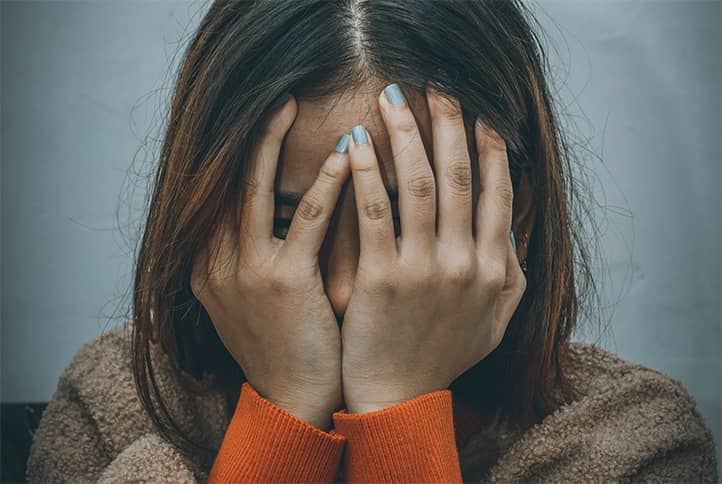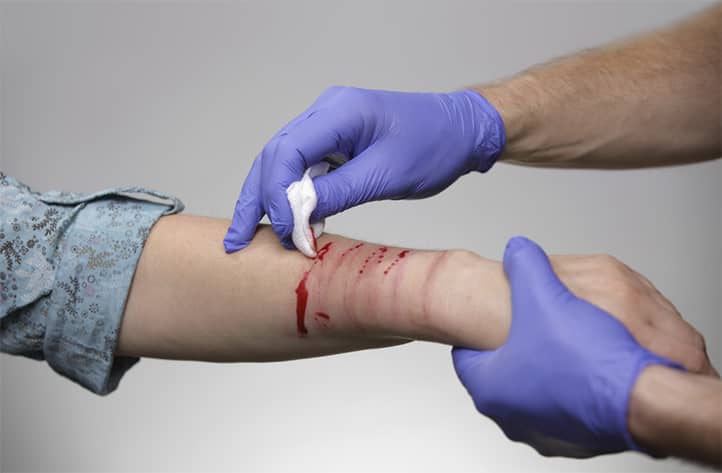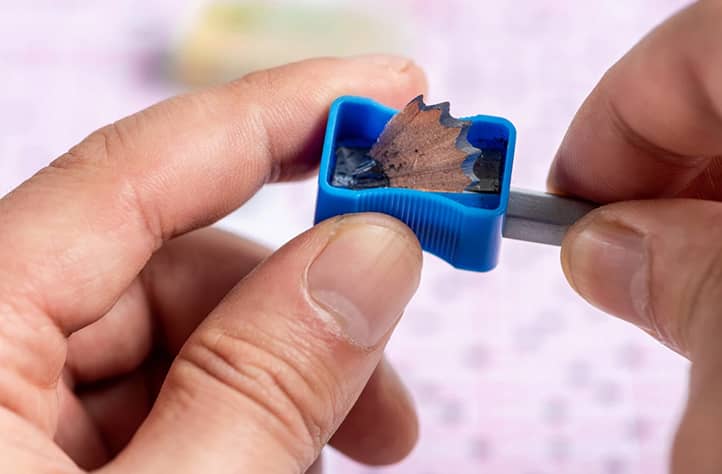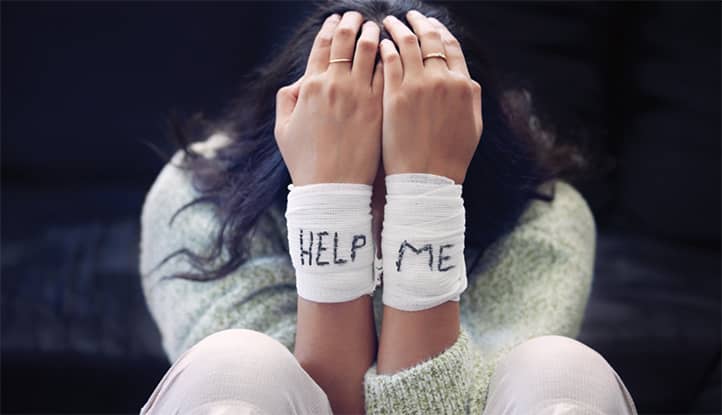Self-harm is a complex phenomenon that is becoming increasingly relevant in modern society. While not a new issue, the sharp rise in cases among youth and adults raises serious concerns. In a world where mental health is becoming a widely discussed topic, self-injurious behavior serves as a critical indicator that individuals do not always have access to adequate emotional support.
Self-harm is often perceived as an act of desperation or even manipulation. However, in reality, it reflects an internal conflict that the individual cannot manage otherwise. This behavior may indicate deep emotional pain, social isolation, or a lack of understanding from others. Studying this issue is crucial for understanding how to help people overcome their difficulties.
According to international studies, up to 17% of young people aged 12 to 24 have engaged in self-harm at least once in their lives. Among adults, this figure is slightly lower but still significant, reaching 5–8%.
In Ukraine, accurate statistics are limited, but experts report an increase in such cases, especially among teenagers. Additionally, the war and the resulting social pressures have only worsened the situation, increasing levels of anxiety, depression, and isolation—common triggers for self-harming behavior.
Interestingly, those most prone to self-harm are individuals who lack access to quality psychological support, live under chronic stress, or experience family conflicts.
An Open Dialogue: The First Step to Breaking the Stigma
Open dialogue about self-harm is the first step toward breaking the stigma surrounding this issue. People who engage in self-harming behavior often face misunderstanding, judgment, and alienation. This creates a vicious cycle where they fear seeking help due to the risk of being judged.
By discussing this issue openly, society can:
- Reduce feelings of shame in those affected. Many people feel “abnormal” or “bad” because of their actions. Open discussions help them realize they are not alone.
- Draw attention to the problem. Without proper attention and support, many cases of self-harm can lead to suicide or chronic mental disorders.
- Prevent the development of dangerous consequences. When people know their feelings are understood and not judged, they are more likely to seek help before the situation becomes critical.
- Increase public awareness. Understanding why people harm themselves enables loved ones and professionals to develop effective methods of support.
Openness on this topic fosters the creation of an empathetic and supportive environment that allows individuals to step out of the shadows of their pain and seek help.

What is Self-Harm?
Self-harm is the intentional infliction of physical harm upon oneself that does not necessarily aim at suicide. It is often a symptom of deep emotional pain that a person cannot cope with in other ways. This behavior is frequently a cry for help or a means of temporarily alleviating mental distress.
Self-harming behavior may occur for various reasons: from striving to relieve emotional tension to a desire to feel a sense of control over one’s life. It should not be regarded as merely attention-seeking or manipulative—most often, it signals a lack of support or coping mechanisms.
Definition of the Concept
Self-harm refers to any deliberate action aimed at causing harm to one’s own body. In psychology, this term is used to describe behaviors that are neither accidental nor unintentional but are driven by a conscious desire to hurt oneself. It is important to emphasize that not all self-harm is suicidal in nature. In most cases, it serves as a way to deal with intense emotions or stress that a person cannot otherwise express or process.
Key Features of Self-Harming Behavior:
- Repetition of actions.
- Absence of suicidal intent (in cases of non-suicidal self-harm).
- Efforts to hide actions from others.
Main Forms of Self-Harm
Self-harm can take various forms, all characterized by their intentional nature. The most common include:
- Cutting: Inflicting cuts on the skin (most often on the arms, legs, or other body parts).
- Burning: Using hot objects or chemicals to create burns.
- Hitting: Striking oneself with hands or objects.
- Scratching: Repeatedly scratching the skin until it bleeds.
- Interfering with wound healing: Deliberately reopening or scratching already healed areas.
- Poisoning: Consuming toxic substances in small, non-lethal doses.
Each form has its unique causes and symbolism for the person engaging in it. For instance, cutting might be a way to “release” emotional pain, while burning may serve as a method of self-punishment for feelings of guilt.
Division into Suicidal and Non-Suicidal Self-Harm
Self-harming behavior can be broadly divided into two categories: suicidal and non-suicidal. They differ in motivation and consequences, making it crucial to understand their distinctions.
Suicidal Self-Harm
Suicidal self-harm refers to actions aimed at ending one’s life. In such cases, the person has a clear intent to die or engages in actions that could lead to fatal outcomes. Suicidal self-harm is often an extreme expression of a state of hopelessness.
Main Characteristics:
- Goal: To end life.
- Often involves careful planning.
- Typically occurs against a backdrop of depression, psychotic disorders, or other severe mental states.
Non-Suicidal Self-Harm (NSSH)
Non-suicidal self-harm refers to actions that do not aim to end life. People use it as a way of temporarily relieving emotional pain, controlling stress, or compensating for inner numbness.
Main Characteristics:
- Goal: To relieve tension, feel control, or shift attention.
- Emotional Component: Often accompanied by feelings of shame, guilt, or loneliness.
- Repetition: Actions may become habitual, serving as a survival mechanism in difficult situations.
Main Causes of NSSH:
- Inability to cope with emotional pain.
- Desire to feel something physically to “break through” inner numbness.
- A way to “punish” oneself for something.
Non-suicidal self-harm is often a complex signal of the need for help. People who harm themselves rarely openly discuss their experiences, making it crucial to pay attention to signs of such behavior.

Causes of Self-Harming Behavior
Self-harming behavior is a complex phenomenon that can be triggered by various factors. Most often, it results from a combination of psychological, emotional, social, and medical causes. People who engage in self-harm usually experience intense emotional pain or inner turmoil they cannot manage through other means. For many, it becomes a way to “release steam” or gain a sense of control in situations where everything seems unmanageable.
Understanding the causes of such behavior is an important step in providing help. Identifying the factors that provoke self-harm allows for a tailored approach to treatment and support while helping to avoid stigmatization.
The primary causes can be categorized into emotional, social, psychological, and medical aspects. It is essential to remember that every case is unique, and often one cause intertwines with another, creating a complex knot of issues.
Emotional Causes
Emotions are among the most common triggers for self-harm. A person may resort to it to cope with feelings that seem unbearable or uncontrollable.
- Emotional overwhelm: Intense emotions such as anger, fear, frustration, or shame can make it feel as though emotions are “overflowing.” In such cases, physical pain becomes a way to shift focus from emotional pain.
- Feelings of inner emptiness: Some people describe feeling completely emotionally “numb.” Self-harm becomes a way to feel alive and real.
- Self-punishment: Self-harm is often accompanied by feelings of guilt. A person may blame themselves for certain situations and attempt to punish themselves through pain.
Emotional causes are particularly common among teenagers, who may not yet have developed mature mechanisms for coping with difficulties.
Social Factors
The social environment significantly impacts mental well-being. In situations where a person lacks support or faces negative influences, self-harm may become a response to external pressure.
- Isolation: A lack of friends, support, or social acceptance leads to feelings of loneliness. In such conditions, a person may seek a way to cope with the sense of abandonment.
- Family conflicts: Problems in relationships with parents or partners, domestic violence, or constant pressure can create chronic stress, which may lead to self-harm.
- Bullying and peer pressure: For children and teenagers, bullying at school or on social media is often a strong trigger. Feelings of alienation and fear of judgment push individuals toward self-harm as a way to cope with emotional pain.
Social factors also include cultural and societal expectations, which can create additional pressure.
Psychological Triggers
Psychological traits are fundamental causes of self-harm. They can develop due to past experiences or chronic inner conflicts.
- Low self-esteem: A person who undervalues themselves or holds a negative perception of their identity is more likely to engage in self-harm, viewing it as a way to express inner dissatisfaction.
- Feelings of guilt: This powerful emotion drives a person to seek “atonement” for their actions or inactions.
- Sense of hopelessness: When a person sees no way to change their life or handle problems, self-harm becomes the only outlet for expressing despair.
Psychological triggers often have a long-lasting nature and are formed under the influence of childhood trauma, bullying, or chronic stress.
Mental Disorders
Self-harm can be a symptom of severe mental disorders. In such cases, it is not merely a behavioral reaction but part of an overarching pathological condition.
- Depression: People with depression often experience intense apathy, hopelessness, and pain. For them, self-harm becomes a way to temporarily “return to reality.”
- Anxiety disorders: Chronic anxiety or panic attacks create a sense of constant stress, from which individuals seek relief through physical pain.
- Post-traumatic stress disorder (PTSD): Individuals who have experienced traumatic events (violence, war, loss) may turn to self-harm as a way to cope with persistent memories or emotions.
- Antisocial personality disorder: In some cases, self-harm may be linked to a desire to manipulate others or demonstrate disregard for social norms.
Mental health aspects require a specialized approach from psychiatrists and psychotherapists, as self-harming behavior may worsen without treatment of the underlying disorder.

Self-Harm as a Cry for Help
Self-harming behavior is often not just an attempt to cope with emotional pain but also a unique form of communication. For many people who resort to such actions, it is a “language” they use to convey their internal struggle and need for help. Often, those who self-harm do not know how else to express their feelings, fears, or needs.
Understanding self-harm as a cry for help, rather than manipulative behavior, is crucial for responding appropriately. Instead of condemnation or ignoring these actions, they require empathy and an effort to understand the true causes of the behavior. Accepting this fact helps to break the stigma surrounding self-harm and provides individuals with the support they so desperately need.
Non-suicidal self-injury is usually not an attempt to manipulate or attract attention. It is a signal that the person feels so overwhelmed or lost that they see no other way to convey their feelings. Educating others to correctly interpret these signals is an important step in creating a safer and more supportive environment for those who are struggling.
How Can Non-Suicidal Self-Injury Be a Form of Communication?
For many people who engage in non-suicidal self-injury, these actions are a way to “say” what they cannot express in words. It is a manifestation of helplessness in trying to reach out to others.
- Lack of other means of self-expression: Some people do not know how to talk about their emotions or lack the emotional support needed to open up. Self-harm becomes a “last resort” for communication.
- An attempt to draw attention to their state: A person may fear speaking directly about their problems, worrying about judgment or misunderstanding. Self-harm is an indirect way to show, “I am struggling, I need help.”
- A form of emotional expression: Through physical pain, a person conveys their inner experiences, such as anger, despair, or loneliness. This may be a way to show others the complexity of their emotional state.
Why Is It Important to See This as a Cry for Help, Not Manipulation?
There is a common misconception that self-harm is an attempt to manipulate others or seek attention. In reality, such behavior is rarely manipulative, and viewing it as such ignores the true nature of the problem.
- It is an expression of internal struggle: A person who self-harms often feels shame or fear of rejection. They do not aim to manipulate but rather seek a way to cope with their condition.
- Risk of stigmatization: Perceiving self-harm as manipulation only increases the person’s isolation and shame. This approach may cause them to hide their actions or avoid seeking help.
- The intent is communication, not control: Manipulation implies a conscious desire to control others. In most cases of self-harm, this is not true. The person often has no clear intention of influencing anyone but is simply looking for an outlet for pain or support.
- The reaction of others matters: Attentive and compassionate responses help the person realize their signal has been seen and understood. Condemnation only deepens their sense of hopelessness and guilt.
It is important to remember that even if self-harm appears to be a way of seeking attention, this does not diminish the seriousness of the situation. A person who resorts to such actions needs understanding and support, not judgment. They require help in finding other ways to express their feelings and needs.

The Difference Between Suicidal and Non-Suicidal Self-Harm
Self-harm is a broad term encompassing various forms of self-inflicted injury. It is important to understand that such behavior does not always indicate a desire to end one’s life. It can be an attempt to cope with emotional pain or a signal for help. This is why distinguishing between suicidal and non-suicidal self-harm (NSSI) is crucial for properly assessing a person’s state and choosing the right approach to their support.
Suicidal self-harm is aimed at ending life. A person engaging in such actions feels such profound despair and hopelessness that they see no other way to resolve their problems. On the other hand, non-suicidal self-harm is a behavior intended to relieve emotional tension or express inner pain without the intention of ending life.
Understanding this distinction helps to respond appropriately to these cases, provide timely assistance, avoid judgment, and prevent the further development of dangerous behaviors.
Key Differentiation Criteria
The difference between suicidal and non-suicidal self-harm lies in the intentions behind the actions and the nature of these actions:
- Intent:
- Suicidal self-harm is aimed at ending life. The person experiences a strong desire to escape pain, suffering, or inner chaos by ceasing their existence.
- Non-suicidal self-harm is intended to cope with emotional pain, relieve tension, or express oneself but not to end life.
- Nature of actions:
- Suicidal actions are typically more serious and life-threatening (e.g., drug overdoses, hanging, jumping from heights).
- Non-suicidal actions may include cutting, hitting, burning, or other forms of injury, which rarely result in fatal outcomes.
- Context:
- Suicidal self-harm is often accompanied by meticulous preparation, farewell notes, or instructions for loved ones.
- Non-suicidal self-harm tends to be impulsive or ritualized and is usually performed in private, without the intent to inform others.
- Emotional background:
- In suicidal cases, the person feels complete hopelessness, emptiness, and a desire to escape life.
- In non-suicidal cases, emotions such as anger, shame, guilt, or overwhelming feelings dominate, making emotions feel uncontrollable.
The Risk of Transitioning from Non-Suicidal Behavior to Suicidal Attempts
Although non-suicidal self-harm is, by definition, not intended to end life, it can be associated with an increased risk of developing suicidal thoughts or behaviors:
- Increased tolerance for pain: Over time, a person who frequently self-harms may lose fear of pain or death, increasing the likelihood of transitioning to more dangerous behaviors.
- Accumulation of emotional exhaustion: If the underlying cause of self-harm remains unresolved, the person may lose hope for improvement, pushing them toward suicidal actions.
- Accidental fatal outcomes: Even without the intent to end life, certain actions may have unforeseen consequences, such as infections, significant blood loss, or severe injuries.
- Psychological risk factors: Individuals who engage in non-suicidal self-harm often experience depression, anxiety disorders, or post-traumatic stress disorder (PTSD), all of which are independent risk factors for suicide.
Non-suicidal self-harm should be viewed as a warning sign, indicating the need for deep support and therapy.
The Importance of Properly Assessing a Person’s State
Recognizing the difference between suicidal and non-suicidal intentions is a critically important task for those trying to help. A mistake in assessment can lead to serious consequences:
- Professional help: Only a specialist can accurately assess the degree of risk. It is crucial to consult a psychologist or psychiatrist for a full diagnosis.
- Non-judgmental questioning: A person who self-harms often feels shame and fear of being judged. Therefore, it is essential to ask questions about their intentions calmly and empathetically to understand their true state.
- Monitoring the state: Even if self-harm appears non-suicidal at first glance, it can escalate quickly. Regularly monitoring the person’s condition helps detect changes in their behavior early.
- Educating loved ones: Family and friends need to be aware of the risks and understand how to respond to such behavior correctly to avoid worsening the situation.
The difference between suicidal and non-suicidal self-harm lies in the intentions and nature of actions. However, even non-suicidal self-harm can be a precursor to more serious issues. This is why it is essential to provide support, accurately assess risks, and involve professionals to help the person find safe and healthy ways to cope with their emotions.

How to Recognize the Problem
Recognizing self-harming behavior is the first step toward providing help to someone in need. Many individuals who struggle with this issue try to hide their actions due to shame, fear of judgment, or misunderstanding from others. This makes detection difficult and poses risks to the person’s physical and mental health. Therefore, it is essential to pay close attention to various signs—physical, emotional, and social.
The problem may reveal itself through external marks on the body or changes in behavior and social activity. For example, scars, burns, or unusually frequent injuries might indicate self-harming behavior. At the same time, emotional outbursts or sudden withdrawal from loved ones could signal an internal crisis the person is experiencing.
Understanding these signs helps identify the problem early, opening the door for conversations about their condition. This gives a chance to prevent the crisis from worsening and help the person find a path to recovery.
Physical Signs
Physical manifestations are the most obvious indicators of self-harming behavior, although many individuals try to conceal them.
- Scars and cuts:
The most common signs include linear scars or fresh cuts on the forearms, thighs, abdomen, or other parts of the body. These areas are often chosen to hide marks under clothing. - Burns:
A person may inflict burns on themselves using cigarettes, lighters, or hot objects. These injuries are also frequently kept hidden. - Frequent injuries:
The appearance of bruises, scratches, or other injuries, often explained by “clumsiness” or accidental incidents. Regular occurrences of such injuries may warrant closer attention. - Use of accessories:
Consistently wearing long clothing (regardless of weather), wide bracelets, or bandanas might be an attempt to conceal wounds or scars.
Careful attention to physical signs can help identify the problem early, even when the person is trying to hide it.
Emotional Manifestations
Changes in emotional state can also be significant indicators of internal struggles that may accompany self-harming behavior.
- Mood swings. The person may appear overly excited at one moment and deeply despondent the next. Emotional “swings” are common in those experiencing intense stress or internal conflict.
- Apathy. Losing interest in activities that previously brought joy is another common sign. This can be a manifestation of depression, which often accompanies self-harm.
- Irritability and aggression. The person might become more irritable or display unprovoked aggression toward others, reflecting their struggle to cope with internal tension.
- Self-criticism. Frequent statements about feeling “inadequate” or persistent guilt can also indicate internal problems.
Emotional manifestations are vital signals, even in the absence of physical signs. They help identify the problem when the person is trying to keep it hidden.
Social Changes
Social behavior also changes in those experiencing crises or engaging in self-harm. This can be seen in their interactions with friends, family, and their professional or academic performance.
- Withdrawal. The person might gradually avoid social contacts, limiting communication even with close ones. This could stem from shame, fear, or reluctance to discuss their condition.
- Decline in performance. At school, university, or work, a drop in productivity may be noticeable. This might include absenteeism, decreased focus, or lack of interest in completing tasks.
- Changes in social circles. The person may start associating with new individuals who exert a negative influence or, conversely, distance themselves from their environment.
- Isolation. Frequent seclusion in their room, avoiding shared activities, or skipping social events are also concerning signals.
Social changes may seem subtle at first, but their combination can point to the possibility of an internal crisis.

Help and Support
Self-harming behavior is often a cry for help, requiring a comprehensive approach that considers the role of close relationships, professional support, and the creation of a safe environment. An inappropriate response, such as judgment, blame, or indifference, can deepen the problem and alienate the person. In contrast, understanding, empathy, and a willingness to engage in dialogue can significantly improve the individual’s condition and prospects.
Support should include actions from those close to the individual who interact with them daily, as well as involvement from professionals. It is also crucial to focus on prevention—creating an environment where the person feels free to talk about their emotions and receive the necessary help before resorting to extreme actions.
For Loved Ones
The role of close ones in helping someone who engages in self-harm is extremely important. They provide emotional support and create an environment where the person feels safe.
- Avoid judgment. Criticism or negative comments can make the person feel ashamed and isolated, worsening the situation. Avoid phrases like, “Why are you doing this?” or “This is pointless!”
- Show empathy. Try to understand what the person is feeling and let them know their emotions matter. For example, say, “I see you’re struggling. How can I help?”
- Listen without interrupting. Sometimes, the best thing you can do is let the person talk without immediately offering advice or trying to fix the situation.
- Don’t ignore the problem. Acknowledge that self-harm is a serious signal and avoid downplaying it with phrases like, “This is just a phase; it will pass.”
- Engage in dialogue. Ask questions like, “How are you feeling?” or “What’s bothering you?” to encourage the person to open up and discuss their feelings.
The response of loved ones can significantly influence the individual’s state. Even simple gestures of care can help them feel they are not alone.
Professional Help
Self-harming behavior is often a symptom of deeper psychological issues requiring professional intervention.
- Psychological support. Consulting a psychologist helps the person find words to express their feelings and discover healthy ways to cope with stress. Regular sessions can be the first step toward resolving the issue.
- Psychotherapy:
- Cognitive-behavioral therapy (CBT). Teaches individuals to recognize negative thoughts and replace them with positive ones, helping to change behavior patterns that lead to self-harm.
- Dialectical behavior therapy (DBT). Particularly effective for those experiencing intense emotional swings, this approach includes self-regulation skills and techniques to reduce emotional distress.
- Medication. If depression, anxiety disorders, or other mental health conditions are diagnosed, a psychiatrist may prescribe antidepressants or mood stabilizers to reduce the intensity of negative emotions. Group therapy:
Interaction with others who have similar experiences can help the person feel they are not alone and learn coping methods from their peers.
Professional help enables the identification of the causes of self-harm and the development of an individualized treatment plan.
Preventive Measures
Preventing self-harming behavior is possible by fostering an environment where individuals feel safe discussing their experiences.
- Emotional literacy education:
Encourage discussions about emotions in schools, families, and communities. Teaching children and adults to recognize and express their feelings can prevent the buildup of internal pain. - Family support:
Parents and relatives should build trusting relationships where the individual feels safe sharing their problems. - Access to information:
Spreading awareness about self-harm and stress management methods helps increase understanding and reduce the risk of such behaviors. - Support in groups:
Employers and educational institutions should promote psychologically safe environments where individuals can seek help without fear of judgment. - Training for educators and leaders:
Teachers and team leaders should be aware of the signs of self-harm and know how to provide initial emotional support.
Preventive measures reduce the risk of self-harming behavior and create a healthy environment for living.

Conclusion
Self-harm is not merely an act of inflicting physical injury on oneself; it is a profound signal of deep emotional pain that the person cannot handle alone. It is essential to understand that this behavior is not a sign of weakness or an attempt to seek attention but rather a cry for help that requires sensitive and thoughtful attention. Recognizing the problem and responding appropriately can be crucial in saving a life.
Support from others plays a vital role in overcoming such behavior. Anyone who encounters self-harm in a loved one must understand that judgment or indifference only exacerbates the problem, while empathy, open communication, and a willingness to help lay the foundation for recovery. It is necessary to learn to notice the signs, listen carefully, and not hesitate to involve professional assistance. This requires time, effort, and patience, but the outcomes are immensely valuable for restoring emotional well-being.
Society also needs to actively work on raising awareness about self-harm. Open discussions, educational programs, and access to resources help break the stigma and create conditions where individuals feel free to talk about their struggles. Everyone can contribute to changing attitudes toward this topic: by supporting a loved one, increasing personal awareness, or sharing information about ways to help.
Despite the severity of the issue, there is always hope for positive change. Professional intervention, the right environment, and support from loved ones provide individuals with the chance to find healthier ways to cope with challenges and overcome their crisis. Recovery is a complex but achievable process where maintaining hope is crucial. Anyone facing self-harming behavior should know: help is available, and life can get better.




